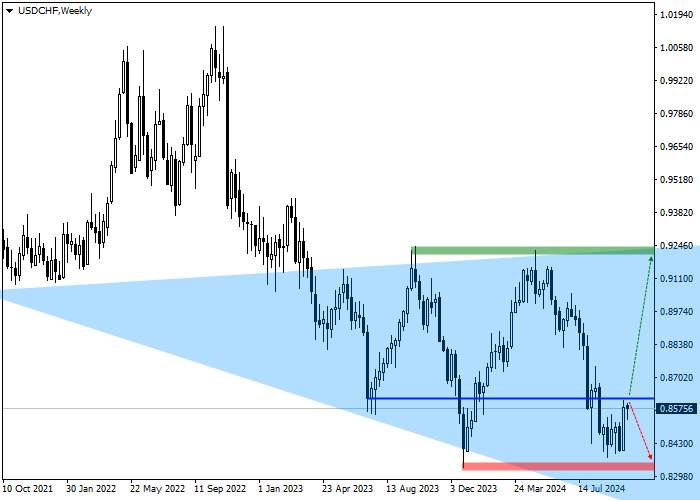Today, we present you a mid-term investment overview of the USD/CHF pair.
In recent months, the main indicators of the Swiss economy have shown positive dynamics, gradually approaching levels of stability. Thus, the producer price index (PPI) increased in August by 0.2% MoM and adjusted from 1.7% to 1.2% YoY, while gross domestic product (GDP) growth in the second quarter amounted to 0.7%, which contributed to an increase in the annual level from 0.6% to 1.8%. Inflation remains even below the target range of 1.0–2.0%, reaching 0.8% in September after 1.1% over the previous period. Thus, the stability of CHF is gradually recovering, but the policy of the Swiss National Bank may put pressure on its position: against the background of a slowdown in consumer prices and an increase in economic indicators, the regulator seeks to bring the interest rate to past values, and at a recent meeting it was reduced from 1.25% to 1.00%.
Problems in the American economy are still present, despite the recovery of the labor and real estate markets. The US Federal Reserve's interest rate was lowered by 50 basis points for the first time in a long time and now stands at 4.75–5.00%, and it is unlikely that the regulator is ready to continue aggressively reducing the cost of borrowing. In August, inflation, for the sake of putting pressure on which interest rates were kept so high, was fixed at 2.5%, which may allow the regulator to reduce the key rate by another 25 basis points in November. Currently, according to the Chicago Mercantile Exchange (CME Group) instrument FedWatch Tool, the probability of a minimum correction in the cost of borrowing at the November 7 meeting is 88.8%. Thus, the onset of this scenario has already been taken into account in the quotes, but it will allow the US economy to get an additional boost, which will support the dollar.
So, for the next quarter, we can assume a neutral or even moderately positive dynamics of the US dollar and a neutral dynamic of the Swiss franc, which will eventually support the trading instrument.
In addition to the underlying fundamental factors, the continued growth of the USD/CHF pair is confirmed by technical indicators: on the W1 chart, the price is held within the correction inside the "expanding formation" pattern with the boundaries of 0.9240–0.8100, unfolding near the support line.

After an unsuccessful attempt to overcome the December 2023 low of 0.8360, the price is attempting a reversal, which can be supported by the fact of the development of the fifth wave inside the "expanding formation" pattern, which is one of the two mandatory waves.
Key levels can be seen on the D1 chart.

As one can see on the chart, the side channel with the boundaries of 0.8520–0.8400 has been broken, and now the quotes are trying to consolidate above the resistance line, around the 0.8580 mark, having completed the reverse testing.
Near the minimum of December 12, 2023, at 0.8340, there is a zone of cancellation of the buy signal; if the price reaches it, open positions should be liquidated.
Around the maximum of May 1, at 0.9220, there is a target zone; if the price reaches it, profit should be taken on open purchase positions.
In more detail, trade entry levels can be evaluated on the H4 chart.

The entry level for purchase transactions is located at 0.8610, which is close to the current price and represents the current monthly maximum. After consolidating above it, there will be practically no serious resistance to strengthen the upward dynamics, and positions can be implemented.
Given the average daily volatility in the USD/CHF pair over the past month, which is 32.5 points, the price movement to the target zone of 0.9220 may take about 49 trading sessions; however, with increased dynamics, this time may be reduced to 37 trading days.






Hot
No comment on record. Start new comment.